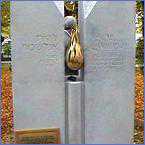20.04.2009 21:17
 /PanARMENIAN.Net/ On April 21, Menora Jewish cultural center, Jewish Religious Community of Armenia and Jewish Community of Armenia will commemorate the victims of Holocaust.
/PanARMENIAN.Net/ On April 21, Menora Jewish cultural center, Jewish Religious Community of Armenia and Jewish Community of Armenia will commemorate the victims of Holocaust.
“This day we meet at the memorial to Holocaust victims, rabbi offers Kaddish (memorial prays) and we light candles. The ceremony starts at 12:00 Yerevan time, which is 10:00 Israel time,” Menora President Willy Vainer told Pan.ARMENIAN.Net.
“On this day, at 10:00 Israel time all countries all over the world remember 6 million victims of World War 2. And on April 24 Jewish of Armenia attend the Armenian Genocide memorial,” he said.
Source: www.panarmenian.net, 20.04.2009

Leave a Reply